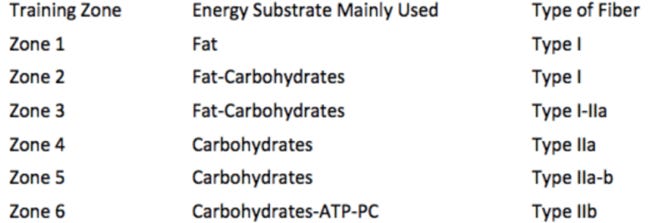Zone 2 Deep Dive: Part One – Understand
Metabolic respiration, lactate thresholds, and classifying training zones by muscle fibre and energy substrate.

Preface
This is part one of a two-part series detailing Zone 2 aerobic training. We’ll focus on understanding what Zone 2 training is this week and then break down the implementation, or how to know we’re in Zone 2 and an optimal exercise protocol for it, next week. This form of aerobic exercise is crucially important since, as I wrote about in an introduction to aerobic and anaerobic exercise, it’s one of the most potent tools available to extend our lifespan. I hope this clears some of the fog that often accompanies this topic. Please enjoy!
What is Zone Two?
Metabolic Respiration and Lactate
From a molecular standpoint, Zone Two (Z2) aerobic exercise is defined as the highest metabolic output you can sustain while keeping lactate levels below two millimole per litre (mmol/L). For context, a healthy individual sitting at rest will have a lactate level of around one mmol/L. Although this may be a useful definition for a dictionary, doctor, or robot, it doesn’t provide us with a practical understanding that we can apply to our own training routine. Let’s break it down, shall we?
As we exercise or engage in any form of movement, our bodies are undergoing the process of respiration. Yes, respiration as in the act of breathing, but also metabolic respiration. Metabolic respiration is the chemical process of using a substrate (glucose, fatty acids, and oxygen) to make energy that we can use – adenosine triphosphate (ATP). We can measure the metabolic fitness of an individual by assessing how much lactate they produce (blood lactate can be measured with a finger prick) and when they start to produce it while undergoing this process of metabolic respiration during exercise.
For example, let’s say a highly trained (and hence metabolically fit) person and an untrained (and hence metabolically unfit) person are cycling on a stationary bike at the same cadence under the same resistance. The untrained individual would start to produce higher levels of lactate sooner which, if it reaches high enough levels, would eventually escape the muscle and enter the bloodstream.
Lactate begins to accumulate when you need to make energy (ATP) faster than you can deliver oxygen to your muscles. This is what’s happening when you engage in more vigorous exercise. Your muscles have greater energy demands than what your body is able to keep up with. I’m oversimplifying here, but if you’re interested in doing a deeper dive on the process of metabolic respiration check out this podcast.
Everyone will start producing lactate at some point, even if you’re Captain America. The differentiator is this. Higher fitness levels are indicated by an individual’s ability to produce higher output while maintaining lactate levels below the two mmol/L threshold. In other words, the healthier and fitter a person is the more work they can do with less lactate. So, Zone 2 helps us to gauge the metabolic health and mitochondrial efficiency of an individual. To really drive this point home, I’ll provide another example.
Let’s say your Zone 2 on a stationary bicycle is 200 watts (watts are a common metric used in cycling to measure output). By definition, this means you can hold 200 watts for a very long period of time since your lactate is not exceeding two mmol/L which is our molecular definition of Zone 2 exercise. Zone two is your all-day pace.
For context: Fun Lactate Facts
Lactate thresholds for most people are around 4 mmol/L. For context, an athlete is likely only able to hold a pace at which their lactate is 4 mmol/L for tens of minutes, if not less.
Lactate threshold is defined as the intensity of exercise at which lactate begins to accumulate in the blood at a faster rate than it can be removed.
Peak output that can only be sustained for a few seconds, such that from a sprint, is around 10 mmol/L (and in some cases >20 mmol/L).
Understanding Training Zones
Up to this point, our understanding of Zone 2 is a form of aerobic training in which we produce maximal output while keeping our lactate levels below two mmol/L. But where does the term “Zone 2” actually come from? It’s one of six training zones that can be used to classify aerobic and anaerobic activities. In order to understand the training zones, we must first understand the basis on which they are designed. Enter centre stage: muscle fibre type and energy substrate utilization.
Muscle Fibre Type
We have two predominant types of muscle fibres which were creatively named Type 1 (slow-twitch) and Type 2 (fast-twitch). The speed of the twitch, slow or fast, refers to how quickly the fibres fatigue. Type 1 muscle fibres fatigue slower as they don’t need to contract as forcefully and are thus used during low-intensity activities.
Type 2 muscle fibres are further divided into two distinct fibres known as Type 2A and 2B. Although there are differences between the two which we’ll cover shortly, for now, we can think of Type 2 muscle fibres as those that contract more forcefully and as a result fatigue more rapidly. These are the fibres that are engaged in more metabolically demanding or vigorous-intensity physical activity such as running at a pace that we can only sustain for five minutes, sprints, or one-minute maximals (exerting max effort for one minute).
Energy Substrate Utilization
We have two primary sources of cellular fuel: fatty acids and glucose. When we use each is best explained by the analogy of a car with two fuel tanks. Fuel tank one contains diesel fuel (fatty acids) and tank two contains regular gasoline (glucose). Our special car also has an intelligent engine that can switch between which tank it’s pulling fuel from based on its external demands.
When we’re driving along a flat road, our engine decides to burn the diesel fuel (fatty acids) since it will be more efficient over long distances. This is our Type 1 muscle fibres burning fatty acids. Remember, Zone 2 is our all-day pace! As we’re driving along, we come into a mountain range. To make it up a steep incline, our engine needs some more power. It decides to switch over to burning the tank containing regular gasoline (glucose). This is our Type 2 muscle fibres burning glucose. We can exert this high output for a few seconds, just enough to make it up the hill, but eventually, energy demands become too high and we need to rest or dial back the intensity.
Not addressed in this analogy is the distinction between Type 2A and 2B muscle fibres which comes down to their relative oxidative and glycolytic capacities. In this context, oxidative refers to the use of fatty acids as an energy substrate whereas glycolytic is in reference to the conversion of glucose for energy.
Type 2A: high oxidative and glycolytic capacity; fatigue relatively slowly.
Type 2B: low oxidative and high glycolytic capacity; fatigue quickly (recruited for short durations under high stress such as an anaerobic sprint).
The Training Zones

The picture painted above with our car analogy is not bimodal (muscle fibre type 1 vs. 2 and fatty acids vs. glucose), but rather operates within a spectrum. That is, we can exercise in six different zones, differentiated by the type of muscle fibre engaged and the predominantly used energy substrate. We move through these zones based on the intensity of the exercise we’re engaging in with Zone 1 being low-intensity everyday life and Zone 6 being absolute maximal output for a very short period of time.
Another way to think about this is that zones 1 and 2 are purely engaging in aerobic functions whereas zones 3 through 6 are a mix of aerobic and anaerobic, where the higher the number the more intense the activity and the shorter period of time we will be able to sustain it. Aerobic exercise is that in which energy (ATP) demands are such that they can be met through the mitochondrial oxidation of fatty acids.
We enter an anaerobic state when energy demands exceed the capacity of mitochondria oxidization and thus need to source fuel from the stored energy (ATP) in the muscle itself. This is when the creatine phosphate energy system (also known as the phosphagen system) is called on in order to resynthesize energy (ATP) that has been stored in the muscle.
Dr. Iñigo San Millán, PhD summarized the differences in energy demands based on the intensity of the exercise we’re engaged in…
“It’s about ATP generation, that’s exercise intensity. So, at low exercise intensities, those slow-twitch muscle fibers, or type 1 muscle fibers, are very well designed to use an energy that is good enough to provide ATP. And yet, you can do this for a very long time. And that’s the diesel gasoline, that’s the fatty acids.
However, as exercise intensity increases, the necessity to produce ATP at a higher rate increases as well. And it gets to a point where fatty acids alone are not enough to produce ATP. Therefore, you need another energy system. And that energy system is glucose, which is a fast energy system.”
The Breakdown: Training Zones
One of the benefits of using these training zones is that they are extremely flexible. The definition remains the same for everyone but the output one will be able to exert within a certain zone is unique as it’s relative to their individual metabolic capacity. How much lactate one produces and how quickly they produce it will depend on their fitness level and inherent biological make-up.
As we covered, type 1 muscle fibres are recruited when we’re operating in the lower training zones. These type 1 muscle fibres have the highest mitochondrial density and volume. The mitochondria are the only place where fat can be oxidized and when we’re training in the lower zones our bodies are oxidizing fat as a source of energy. In effect, we’re training the mitochondria while engaged in Zone 2 exercise. Zone 2 is often called “fat burn” or “fatmax” training. This is also a valid way to think about it since it’s the highest intensity at which we can exercise while being in a purely aerobic, type 1 muscle fibre engaged, and fat oxidizing state.
The reason that Zone 2 is the most effective form of aerobic exercise, compared to Zone 1 or 3, is because it’s where the mitochondria produce maximum ATP output while under purely aerobic conditions. When we increase output and move beyond Zone 2, our type 2A muscle fibres start to be engaged (see the chart above). This means that Zone 2 is where our slow-twitch muscle fibres are stimulated at their highest possible capacity before we start to engage some fast-twitch fibres.
As intensity increases, we transition to higher energy systems in order to generate more energy (ATP). Eventually, energy demands can no longer be supported by fat alone and our fuel source switches to glucose along with the changing of muscle fibres recruited from slow to faster twitch. As such, there’s a drop in fat oxidization and an increase in glucose oxidization that corresponds with moving from Zone 2 to 3 and beyond. This increased reliance on glucose (carbohydrates) as an energy source results in more lactate production which leads to quicker fatigue. The higher the zone, the more lactate production, and the shorter duration one can sustain output.
Moving Forward
Now that we’ve built a foundation for a better understanding of aerobic and anaerobic exercise, specifically what constitutes Zone 2 training, we can move forward next week with how to implement an optimal Zone 2 training regimen into our weekly routine.
And, as always, please give me feedback on Instagram or by hitting reply to this email.
Much love,
Jack




